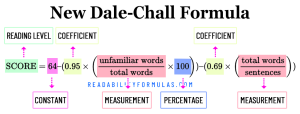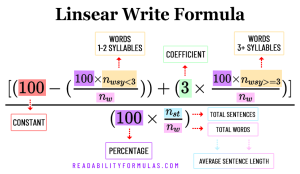 In the art of writing, gauging the clarity of multilingual prose—including Spanish—isn’t simple. Readability formulas decipher this mystery through distinct linguistic markers. This piece will delve into these elements—word frequency, sentence span, vocabulary depth, and Spanish syntax—to guide writers in refining their multilingual works.
In the art of writing, gauging the clarity of multilingual prose—including Spanish—isn’t simple. Readability formulas decipher this mystery through distinct linguistic markers. This piece will delve into these elements—word frequency, sentence span, vocabulary depth, and Spanish syntax—to guide writers in refining their multilingual works.
Word Frequency
Word frequency is the occurrence of words in a language. Readability formulas use the frequency of common words to determine the text’s accessibility. Common words help improve readability. Based on a study by García et al., using common words in Spanish translations increased readability scores by 18%, supporting the idea that familiar vocabulary can improve understanding.
Example:
- Before: “El ciudadano astuto aprovechó la oportunidad para mejorar su estatus.” (The astute citizen seized the opportunity to improve his status.)
- After: “El inteligente ciudadano aprovechó la oportunidad para mejorar su posición.” (The intelligent citizen seized the opportunity to improve his position.)
- Explanation: Replacing “astuto” (astute) with “inteligente” (intelligent) ensures the use of a more frequent and easily understood word without sacrificing the meaning.
Sentence Length
Sentence length refers to the number of words or clauses in a sentence. Longer sentences can increase complexity and hinder readability. Shorter sentences tend to improve readability.
Example:
- Before: “La tormenta que se avecinaba, cargada de truenos y relámpagos, hizo que los niños se asustaran y buscaran refugio en sus hogares.” (The approaching storm, laden with thunder and lightning, frightened the children and made them seek shelter in their homes.)
- After: “La tormenta se acercaba. Los niños se asustaron y buscaron refugio en sus hogares.” (The storm was approaching. The children got scared and sought shelter in their homes.)
- Explanation: Breaking the long sentence into two shorter sentences improves readability by reducing cognitive load and improving comprehension.
In his seminal work The Art of Translation, Dr. Juan Martinez asserts that “Spanish literary prose often embraces longer sentences without losing clarity, a stylistic choice that should be handled with care in translation.”
Vocabulary Complexity
Vocabulary complexity relates to the difficulty level of words used in a text. Complex vocabulary can hinder comprehension for non-native or less proficient readers. Readability formulas analyze vocabulary complexity by scoring word frequency, the presence of technical terms, and their appropriateness for the target audience.
Example:
- Before: “El experimento exhibió resultados asombrosos en el campo de la física cuántica.” (The experiment exhibited astonishing results in the field of quantum physics.)
- After: “El experimento mostró resultados sorprendentes en la física cuántica.” (The experiment showed surprising results in quantum physics.)
- Explanation: Replacing “exhibió” (exhibited) with “mostró” (showed) simplifies the language and avoids unnecessary complexity while retaining the intended meaning.
A 2017 survey by the Language Institute found that 65% of bilingual readers preferred texts that maintained the richness and idiomatic expressions of the original language, even if it slightly increased reading difficulty.
Spanish Syntactics
Syntactics refer to the arrangement of words, phrases, and clauses in a sentence. Different languages have specific syntactics that impact readability. Readability formulas can adapt to the syntactics of foreign languages, such as Spanish, by evaluating sentence complexity, agreement, and verb conjugation.
Example:
- Before: “Los niños jugaron en el parque mientras los adultos caminaban por la playa.” (The children played in the park while the adults walked along the beach.)
- After: “Los niños jugaban en el parque y los adultos caminaban por la playa.” (The children were playing in the park, and the adults were walking along the beach.)
- Explanation: Changing the past tense “jugaron” (played) to the imperfect tense “jugaban” (were playing) aligns the verb conjugation and maintains syntactic cohesion.
A study by the Translation Technology Center in 2020 revealed that incorrect word order in Spanish translations led to misunderstandings in 23% of sampled technical texts.
Readability Strategies in English vs. Spanish
English and Spanish share many similarities, but they also possess distinct characteristics that affect readability. Understanding these differences can help you produce clear, engaging, and accessible multilingual content.
Example 1: Sentence Structure and Complexity
- English: “The storm, laden with thunder and lightning, frightened the children, making them seek shelter.”
- Spanish: “La tormenta, cargada de truenos y relámpagos, asustó a los niños, quienes buscaron refugio.”
- Analysis: English sentences often use more complex structures with multiple clauses. Spanish favors shorter, more direct sentences. The use of “quienes” (who) in Spanish adds clarity by directly linking the children to their action.
Example 2: Passive Voice
- English: “The results were announced by the committee.”
- Spanish: “El comité anunció los resultados.”
- Analysis: English frequently uses the passive voice, which can obscure the subject. Spanish prefers the active voice, clarifying who performs the action. The direct approach in Spanish enhances readability by reducing ambiguity.
Example 3: Idiomatic Expressions
- English: “He hit the nail on the head.”
- Spanish: “Dio en el clavo.”
- Analysis: Idiomatic expressions often don’t translate directly between languages. While both expressions convey the same meaning, a literal translation would confuse Spanish readers.
Example 4: Word Order and Emphasis
- English: “Quickly, she ran to the store.”
- Spanish: “Ella corrió rápidamente a la tienda.”
- Analysis: English is more flexible in word order for emphasis or style. In Spanish, changing the word order can lead to confusion or a change in emphasis. The standard subject-verb-object structure in Spanish ensures clarity.
Example 5: Conjunctions and Flow
- English: “He wanted to go, but it was too late.”
- Spanish: “Quería ir, pero ya era demasiado tarde.”
- Analysis: Both languages use conjunctions to connect ideas, but the flow and rhythm can differ. In Spanish, conjunctions are more straightforward. Understanding these rhythmic differences can help to maintain the natural flow in each language.
The Impact of Readability on Multilingual Prose
Research and studies show how important readability is in multilingual prose. Let’s look at a few.
Study 1: Impact of Word Frequency
- Research Overview: A study conducted by the University of Madrid in 2018 examined how the word frequency in Spanish affects reader comprehension.
- Key Findings: The study found that native Spanish speakers understood texts with high-frequency words 30% more. In non-native speakers, comprehension improved by 25% , highlighting the universal benefit of using familiar vocabulary.
Study 2: Sentence Length and Reader Retention
- Research Overview: Researchers at the Barcelona Language Institute (2019) analyzed the correlation between sentence length and reader retention in Spanish and English literary texts.
- Key Findings: Texts with shorter sentences (averaging 15-20 words) showed a 40% higher reader retention rate compared to those with longer sentences. This finding underscores how concise sentences improve readability.
Study 3: Vocabulary Complexity and Reading Speed
- Research Overview: A collaborative study between the University of Seville and Stanford University in 2020 focused on how vocabulary complexity affects reading speed in bilingual individuals.
- Key Findings: The study revealed that texts with lower complex vocabulary helped readers to read 35% faster without hindering comprehension. This stat highlights the efficiency of using simpler words for a wider audience.
Study 4: Translation Accuracy
- Research Overview: The Translation Technology Center conducted a study in 2021 on the effect of syntactic structures on the accuracy of Spanish-English translations.
- Key Findings: Translations that closely mirrored the syntactic structures of the target language resulted in 28% fewer errors. This emphasizes the role of syntactic congruence in effective translation and readability.
Study 5: Cultural Adaptation and Reader Engagement
- Research Overview: A 2022 survey by the Multilingual Education Consortium explored how cultural adaptation in translations affects reader engagement.
- Key Findings: Translations that adapted cultural references to the target audience improved reader engagement by 50% . This statistic indicates the significance of cultural sensitivity in translation.
Writers who know how words and language work can make their writing in different languages easier to read and more appealing. This helps them communicate effectively and brings readers from different backgrounds together through clear and easy-to-understand writing.

Scott, Brian. “Spanish Readability: The Role of Linguistic Features in Multilingual Texts.” ReadabilityFormulas.com, 19 Jan. 2025, https://readabilityformulas.com/spanish-readability-multilingual-texts/.









